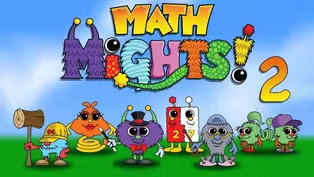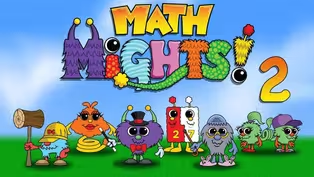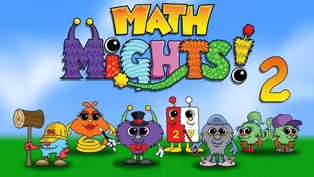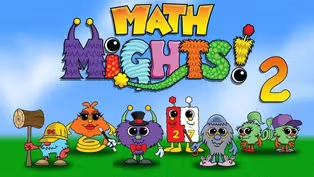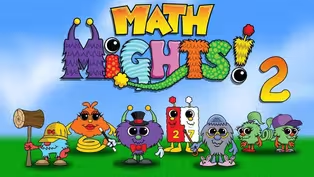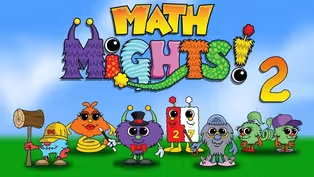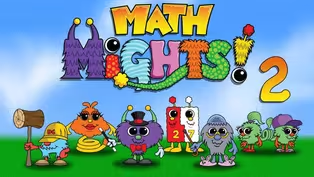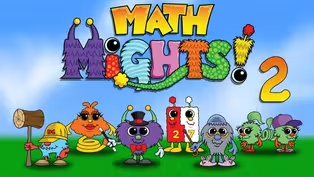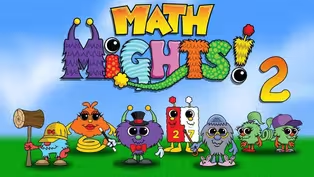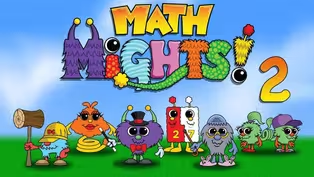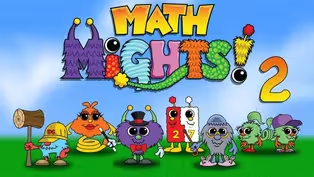Math Mights
Comparing Numbers on a Number line
Season 3 Episode 303 | 15m 59sVideo has Closed Captions
Join Mrs McCartney for a word problem with Professor Barble using Visula Models!
Join Mrs McCartney for a word problem with Professor Barble using Visula Models! Next great ready to locate and compare 3-digit numbers on a number line! We may even see our friend Value Pak to help us!
Problems playing video? | Closed Captioning Feedback
Problems playing video? | Closed Captioning Feedback
Math Mights is a local public television program presented by Detroit PBS
Math Mights
Comparing Numbers on a Number line
Season 3 Episode 303 | 15m 59sVideo has Closed Captions
Join Mrs McCartney for a word problem with Professor Barble using Visula Models! Next great ready to locate and compare 3-digit numbers on a number line! We may even see our friend Value Pak to help us!
Problems playing video? | Closed Captioning Feedback
How to Watch Math Mights
Math Mights is available to stream on pbs.org and the free PBS App, available on iPhone, Apple TV, Android TV, Android smartphones, Amazon Fire TV, Amazon Fire Tablet, Roku, Samsung Smart TV, and Vizio.
Providing Support for PBS.org
Learn Moreabout PBS online sponsorshipMore from This Collection
"Math Mights" lessons for 2nd Grade students.
Video has Closed Captions
Join Mrs. McCartney for some fun with Professor Barble. (15m 59s)
Video has Closed Captions
Join Mrs. McCartney for some fun with Professor Barble. (15m 59s)
Video has Closed Captions
Join Mrs. McCartney for some fun with Professor Barble doing a tricky comparison. (15m 59s)
Video has Closed Captions
Join Mrs. McCartney for a word problem with Professor Barble that will make more sense. (15m 58s)
Video has Closed Captions
Join Mrs. McCartney for a comparison word problem with her friend Professor Barble. (15m 59s)
Compare 3-Digit Numbers Part 2
Video has Closed Captions
Join Mrs. McCartney to learn how to do a comparison word problem with Professor Barble! (15m 59s)
Compare 3-Digit Numbers Part 1
Video has Closed Captions
Join Mrs. McCartney to see if we can figure out Professor Barble's comparison. (15m 59s)
Numbers represented in different ways
Video has Closed Captions
Representing numbers in different ways to show off your learning with place value. (15m 59s)
Video has Closed Captions
Put numbers together and taking them apart with expanded form. (15m 59s)
Video has Closed Captions
Join Mrs, McCartney for a Number Talk with her friend Springling! (15m 59s)
Video has Closed Captions
Join Mrs, McCartney for a Number Talk with her friend Springling! (16m)
Subtraction with 2-Digit Numbers Part 2
Video has Closed Captions
Join Mrs. McCartney for an addition number talk with D.C.! (16m)
Providing Support for PBS.org
Learn Moreabout PBS online sponsorship(dramatic orchestral music) (air swooshes) (magic chimes) (Springling boinging) (Dotsan screaming) - [Kids] Math Mights.
- Welcome to 2nd grade Math Mights.
I'm so excited that you've joined us today.
My name is Mrs. McCartney, and we have a lot of math fun scheduled for you.
Let's check out our plan for today.
First, we're gonna start off with a warmup with my friend, Professor Barble doing word problems, and then after that, we're going to start to compare three-digit numbers on a number line.
Let's start off first with warming up our brain with my friend Professor Barble.
He loves to conquer word problems with 2nd graders by using visual models.
You might be asking yourself, what is a visual model?
Well, there's three good things to know about visual models as a second grader especially when we're talking about word problems.
Sometimes they're also known as model drawings, unit bars, tape diagrams, and even bar models.
Honestly, it's a great reading comprehension strategy for you to use as a 2nd grader when doing word problems.
And the last part of it really helps you just to be able to draw a visual model that helps you visualize the strategy and really understand what the word problem is asking instead of just guessing if you should add or subtract.
Let's check out our friend, Professor Barble, who has come to us all the way from Mathville to help us with our word problems today.
Professor Barble comes to us all the way from Mathville.
He loves to take tours of Mathville and runs into different types of word problems while he's going on his hikes.
He oftentimes wants to remind students to slow down during word problems and not guess on which operation.
If he stops and thinks, a starting line comes out of his hat to help him to be able to begin his visual model.
Professor Barble has a visual model today that he wants you to see if you can guess what the word problem was that he was encountering.
Take a look at that word problem.
Can you guess what professor's word problem was?
My friend Benita has an idea.
She thinks that we just need to add to solve the problem.
Wait a minute, we don't wanna just solve the problem.
The question that Professor Barble asked us was, what story problem that he encounter to make that word problem come out on his starting line with his thinking cap.
Let's see what our friend Olivia thinks that the word problem says.
She says Professor Barble and his students have to find 42 diamonds.
They found 24.
How many more diamonds do they need to find?
Let's take a look at the problem here to see how it's drawn out to see if what Olivia said makes sense.
She said there was 42 diamonds altogether, which I can see that the whole visual model at the end says 42.
She says they found 24, it's labeled found, and the question mark says how many they need to find.
I think her story problem matches the visual model that Professor Barble had us guess.
Great job, Olivia.
Did you think of that word problem the way that Olivia did?
A visual model should be drawn to the point that you can look at the visual model and know what the word problem is that the person was solving because it's that reading comprehension strategies that's gonna help us to be able to solve word problems.
Guess what?
Professor Barble wants to know how you think word problems are helping you with a visual model.
They really help us to slow down in 2nd grade.
This time, we're gonna try it again, now that we have the language down on the understanding for what a visual model is, but we're gonna see if we can guess his word problem and then we're gonna go ahead and solve.
Let's take a look at the problem that Professor Barble has for us.
I can see that there's fish in the tank, there's guppies and goldfish.
I wonder what the word problem is that Professor Barble read that caused him to draw that visual model.
Let's see what our friend Benita thinks.
Benita thinks that the word problem said there were 42 fish in the tank, 15 of them were goldfish and the rest were guppies.
How many guppies are in the tank?
I think that sounds like a great idea for that problem.
Let's take a closer look to see if her problem makes sense.
The bar represents the fish in the tank and we have that labeled here.
We have the total of 42 fish, 15 of them and it's labeled goldfish are here, we don't know how many guppies.
So, there's guppies here with the question mark.
This problem makes so much more sense that we stopped and kind of look to see what it was asking.
We have the total and the part, we have to figure out the other part.
So in order to do that, we could use different strategies.
I'm gonna use our friends Sprinkling on an open number line and count up from 15 to 42 to figure out what our other missing part is.
So, we wanna answer 42, that's the total fish, we're gonna take away the goldfish to see how many guppies there are.
So, I'm gonna start my number line at 15 and I'm gonna end it at 42.
I might want to start by just going to a friendly number 20, the distance between 15 and 20 is five.
I'm gonna go ahead now, instead of going to the 30, I'm gonna go all the way to 40 because Sprinkling loves to take big hops.
This is a hop that sprinkling would like, from 20 to 40.
That is easy 'cause it's only 20 away.
40 to 42, we know is only two away.
So, if I add this together; five plus 20 plus two, we know is 27.
Therefore, we know that 27 guppies are in the tank, 15 goldfish to give us our total of 42.
See, doing a visual model helps you do the computation in a snap.
It's so easy to see exactly what the word the problem is asking when we slow down like Professor Barble wants us to do.
Great jobs 2nd grade Math Mights.
Let's check out our I can statement for the day.
Our I can statement reads, I can locate, represent, and compare three-digit numbers on the number line.
Let's take a look at these three number lines.
Each of them is different in one way or another.
What do you notice that's the same and different about these number lines?
Let's take a look to see what our friends think.
Our friend Olivia said, "They all have 10 sections between the start and the end marks."
Benita says they all start with zero.
They're all the same length but they have different ranges of numbers.
Let's take a look at those here.
If I look at this on the overhead here, I can see these three different number lines.
Our friend Benita said that she sees they all start with zero, which I see there, they're all the same length but the ranges, the numbers are different, which is correct.
There is 10 sections in each of these.
So, this is going to go to 10, that's gonna go to 100, and this is going to go to 1000.
I wonder if you're able to locate based on that these number lines, these three numbers.
Can you locate the number three, the number 30, and the number 300.
Let's act that out so we can see that together.
If I'm gonna show the number three, I know that there's 10 marks, which is what Olivia just told us.
If I wanted to go ahead and mark three, I know this is one, two, three.
So, I'm gonna go ahead and put a circle here and mark that that is where three would be.
Where would 30 be?
That's a little bit harder because it goes to 100.
There's no way I can start counting one, two, three four.
What do you think these tick marks are in between if this is going to total 100?
Well, if we skip count by tens, would we end up hitting it?
10 20, 30.
So here, I'm gonna go ahead and mark on this number line 30, because these spans are 10 to get us to 100.
Now let's take a look at 1000.
Where do you think 300 would be on this number line?
They're all the same length.
The first one was going up by ones, the second one was going up by tens, the third one hits 1000.
So, what are you thinking that we'd have to go up by?
I'm thinking that each of these sections must equal 100.
So, if we started here 100, 200, 300, I could plot the number 300 here.
What have you noticed about these number lines?
Not every number line is exactly the same.
They might be the same length and they might even be sectioned the same but the actual quantity of the numbers depends on the value.
Now I want you to take a look at three different number lines.
Can you figure out the labels for each of the points that you see?
Take a close look at those number lines because they added a different number.
So those increments in between probably are going to be different.
Let's take a look at this first number line.
It starts at zero and it ends at 1000.
It has those same 10 hashes there in between each of the sections.
I wonder if each of these sections is worth 100.
Let's see, 100, 200, 300, 400, 500, 600, 700, 800, that would make this 900, where this point is.
Now I'm gonna try to trick you.
Let's look at a different number line.
I want you to pay close attention to where the number line starts and where the number line ends because that's gonna change what's in the middle.
This one starts at 620 and ends at 630.
Wait a minute, I'm not gonna be counting by hundreds right now.
Am I gonna be counting by tens from 620 to 630?
I think I have to go back to counting by ones.
620, 621, 622, 623, 624, 625, 626, 627, 628, 629.
Some of you may have been saying, Ms. McCartney, we could have gone backwards from 630 and just gone back one.
If you start to understand number lines that way it will be a lot quicker to go that way.
Now let's check out the last number line to see if it's gonna be counting by tens or ones or maybe even a hundred.
We have 200 and it ends at 300.
I certainly am not gonna count by ones 'cause it would be way more parts in the between, and I'm not gonna count by hundreds 'cause I only have a whole hundred worth here.
Let's start with 200, 210, 220, 230, 240, 250, I know that I can locate 260 and you can check it 270, 280, 290, 300.
Did you notice how each of the number lines that we looked at change?
They don't always start at zero.
We know that from Sprinkling and an open number line.
Number lines can start and stop wherever you want them to, but you have to be careful to see where the beginning point and the ending point is and carefully look at the distance in between to see are they counting by ones by tens are a hundred?
Let's check out what Olivia and Benita did.
They compared the numbers 371 and 317 but they represented their thinking a different way.
You can do that when you're comparing numbers.
You may have one strategy that you use but your friend may have a different strategy.
It looks like Benita use the number lines that we've been talking about to compare.
Let's check it out.
Benita said, "I see that 371 is further to the right on my number line.
So, I know it's greater than 317."
Let's take a look at the number line here.
She says 371 is greater than 317.
She said her reasoning for that is because she plotted the 371 on her number line and then she plotted the number 317.
We know on the right of the number line, the numbers are getting greater.
When we go to the left, obviously, the numbers are getting less.
I think she has some really great thinking here.
You can use a number line to decide whether or not a number is greater, or if it's less depending on the location of it on the number line.
Is that the only way that we can compare numbers in 2nd grade?
Let's check out to see what Olivia did.
She said, "I see 3 hundreds for each number.
317 only has one 10, but 371 has seven tens."
Let's take a look here to see exactly what she means.
We have the number 371 and here we have the number 317.
She compared and said, wait a minute, these both have 300.
So that would mean those are equal in the hundreds.
So, then she moved on to the tens.
She noticed this one has seven tens and this one only has one ten.
Therefore, seven tens is greater than one 10.
So, she feels that that statement is true with our Allie the Alligator, 'cause he's going to eat the larger number as you learned about in 1st grade.
So, we know that this statement is true.
371 is greater than 317.
What was the same and what was different about Olivia and Benita's representations?
We know Olivia used the base 10 blocks which really helped her to look at the values of the numbers.
And then Benita decided to do a number line which is also a really great way to compare numbers.
It's now your turn to see if you can try comparing numbers on a number line.
You're gonna plot the two numbers in a number line and compare to see if you can find the number that's greater or less.
We're gonna do a lot of comparing in 2nd grade in these few episodes together because that's a really important 2nd grade skill.
I've had so much fun hanging out with you today from our problem with Professor Barble and getting the idea of how to plot a number on different number lines.
And then for us to go ahead and figure out how to compare numbers.
I sure hope that you join me next time.
(orchestral music) (upbeat music) - [Kid] sis4teachers.org.
Changing the way you think about math.
- [Narrator] This program is made possible with funding from the Michigan Department of Education Governor's Education Emergency Funds, the State of Michigan, and by viewers like you.
(upbeat music)


- Home and How To

Hit the road in a classic car for a tour through Great Britain with two antiques experts.












Support for PBS provided by:
Math Mights is a local public television program presented by Detroit PBS
